Every year Treasure Hill Artist Village (寶藏巖國際藝術村) hosts an art residency for international and local artists selected through an open call process. Today the four resident artists of this season are opening a group exhibition, 2017 Season 4 Treasure Hill Residency Artists Exhibition (2017第四季寶藏巖駐地藝術家聯展), which offers a glimpse of projects they have been working on during their stay in Taipei. Japanese artist Kayako Nakashima’s Make the Holes to Get New Wind is a dark room with walls punctuated with drilled holes. The changing sunlight peers through the holes, creating illumination in the room that shifts over time. Lee Yung-ta’s (李勇達) A Fictitious Village is a writing project that calls into question the authority of those who have operated Treasure Hill since its legalization. Lee writes about fictional stories that take place in the neighborhood and places these written stories under bricks and stones. “Even if they were under the pressure of stones, the fictitious stories are free,” writes Lee. While Nakashima and Lee present works that are specific to Treasure Hill, artist Chu Yun-tien’s (朱韻恬) project addresses his experience of departing and returning to Taiwan and observations about changing external and internal sceneries over the lapse of time. Pamela Varela’s installation Bodies Women Cities I — Taipei explores the feminine body as a continuous process between the public and private that is closely linked with its surrounding political and social climate.
■ Treasure Hill Artist Village (寶藏巖國際藝術村), 2, Alley 14, Lane 230, Tingzhou Rd Sec 3, Taipei City (台北市汀州路三段230巷14弄2號), tel: (02) 2364-5313. Opens Tuesdays to Sundays from 11am to 6pm.
■ Until Dec. 24
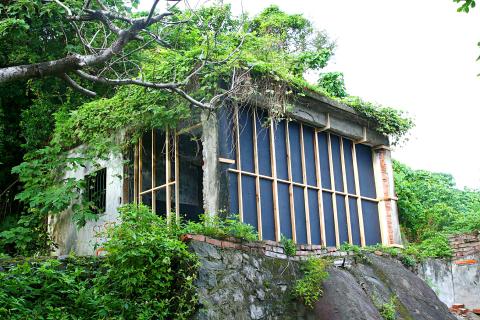
Photo Courtesy of Treasure Hill Artist Village
Artist Hsu Che-yu’s (許哲瑜) solo exhibition Re-rupture (重新破裂) looks back on two seemingly unrelated events that reflect the social and political climate in Taipei during the 90s. One event is a failed anarchic art festival by Wu Chung-wei (吳中煒) that originally planned to drop a series of items, including a washing machine, a boiling hot pot, a statue of Chiang Kai-shek (蔣介石) and a sex doll from the sky to create a mountain of destroyed objects. The other event is a large-scale group fight among taxi drivers and mafia over political allegiances under Chongxin Bridge (重新橋). In Hsu’s single channel film that featured in the show, a group of taxi drivers who partook in the incident return to the site of the fight for a ritualistic action of spraying a yellow cab entirely white. In another scene, a guitar player is hung sky-high above Wu’s intended festival site, enacting a segment of the festival that never came to be. The film is accompanied by a series of objects, including a suspended washing machine and a Chiang Ching-kuo (蔣經國) sculpture created by Wu’s father, a prominent state artist during Chiang’s administration of Taiwan. Through film, photographs, text and installation, the show draws from these past events while shedding light on their relevance to today’s social and political climate.
■ Howl Space (齁空間), 163, Yongfu Rd Sec 2, Tainan City (台南市永福路二段163號), tel: 0987- 497-491. Opens Wednesdays to Sundays from 1pm to 6pm.
■ Until Dec. 3
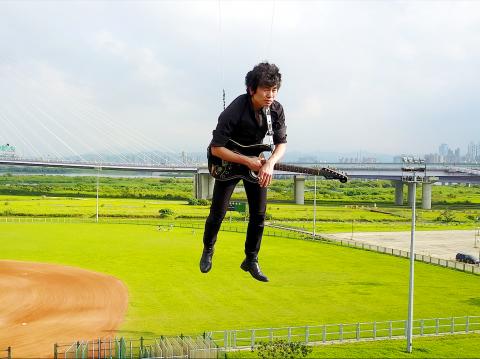
Photo Courtesy of the artist
The Ocean After Nature is a traveling exhibition beginning with the theme of the sea as a departure point to address the political, economic, cultural and ecological state of affairs in today’s globalized world. Curated by Alaina Claire Feldman and produced by Independent Curators International, the exhibition showcases the works of 10 emerging and established artists, including one local artist invited by the host organization. The show opens this weekend at TheCube Project Space with a curator’s talk scheduled for next Thursday. Catch the special screening of essayistic documentary film The Forgotten Space by legendary artist Allan Sekula and Noel Burch that explores the contemporary maritime world of labor, economy and power structures associated with the sea.
■ TheCube Project Space (立方計畫空間), 2F, 13, Alley 1, Lane 136, Roosevelt Rd Sec 4, Taipei City (台北市羅斯福路四段136巷1弄13號2樓), tel: (02) 2368-9418. Opens Wednesdays to Sundays from 2pm to 8pm.
■ Until Jan. 28
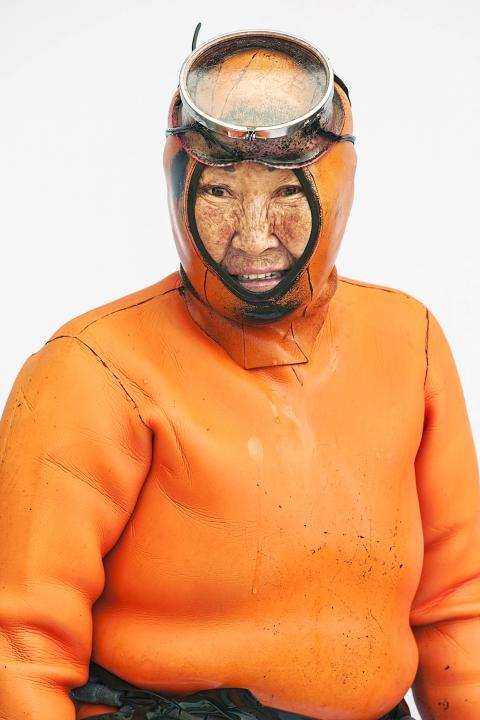
Photo Courtesy of the artist
Lu Plus Textile Exhibition (儒家布藝展) at Hermit’s Hut showcases some 90 articles of textile designed for use during Chinese tea ceremonies and meditative interiors. Lu Plus is a textile brand designed by artist Chinchi Lu (津姬) who specializes in patch-work textile. Together with the tea house Hermit’s Hut (三徑就荒), Lu has created a line of table cloth, small tea cloth and decorative drapery made with new and old fabric that follow a subdued color template of white, blue and gray. Lu appreciates the worn out weaves of old fabric, the way they are stretched irregularly with distinct characteristics. Over the years, she has traveled the world collecting fabric from different cultures for her creations. Lu began working with cloth as a young child, gathering remaining pieces from her cousin who worked as a tailor. Her patched cloths can be used for tea-making occasions as well as appreciated as individual artworks of handcraft.
■ Hermit’s Hut (三徑就荒), 15, Lane 546, Ruiguang Rd, Taipei City (台北市忠孝東路四段553巷46弄15號), tel: (02) 2746-6929. Opens Wednesdays to Mondays from 1pm to 8pm (Saturdays and Sundays from 11am to 8pm).
■ Until Dec. 3
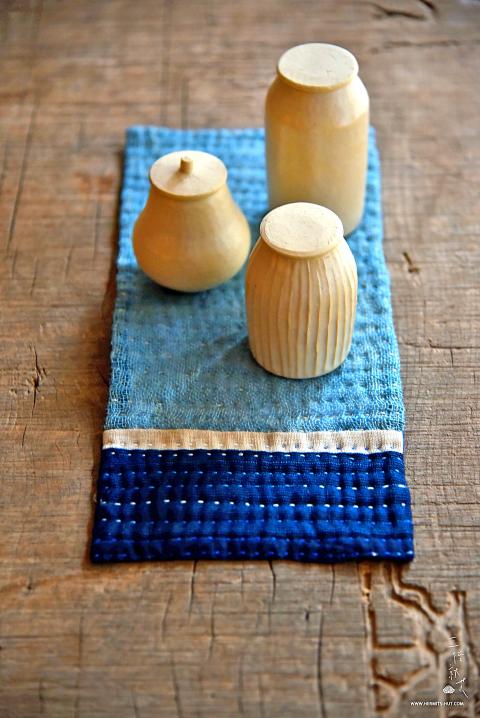
Photo Courtesy of Hermit’s Hut
Young artist Hsieh Ching’s (謝青) solo exhibition The Sky is Dark But You Are Light (天黑了,但你是亮的) showcases a series of drawings, screen prints, sculpture and installation that feature a recurring cartoon human character with a white exaggerated body outlined by simple black contours. Throughout the exhibition, the character poses in different fantastical scenarios, at times strolling under the moonlight, and other times undergoing some form of bodily metamorphosis, such as becoming a ceramic cup. “This little person is a fragment of me; it is a mirror through which I look at myself,” says the artist. In a gridded series of black and white prints overlaid with sensual watercolor marks, the little person remains in the same position while its surroundings flutter with changing colors and abstractions. In the far corner of the exhibition room, the little person’s head is molded into small snowball-like balls and scattered on a beige cloth unevenly laid on the floor. Through this fantastical world, Hsieh processes her personal journey of desires, fears, sadness and anxiety.
■ Good Life Place (好感生活所事), 24, Lane 83, Nanning St, Tainan City (台南市南寧街83巷24號), tel: 0975-267-265. Opens Mondays, Tuesdays, Thursdays from 2pm to 9pm, Saturdays from 6pm to 10pm and Sundays from 9am to 9pm.
■ Until Dec. 3
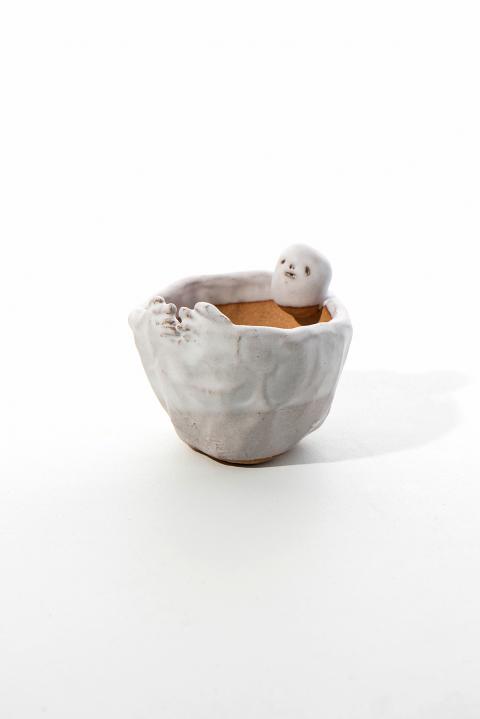
Photo Courtesy of the artist
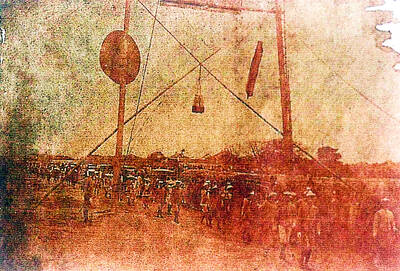
June 23 to June 29 After capturing the walled city of Hsinchu on June 22, 1895, the Japanese hoped to quickly push south and seize control of Taiwan’s entire west coast — but their advance was stalled for more than a month. Not only did local Hakka fighters continue to cause them headaches, resistance forces even attempted to retake the city three times. “We had planned to occupy Anping (Tainan) and Takao (Kaohsiung) as soon as possible, but ever since we took Hsinchu, nearby bandits proclaiming to be ‘righteous people’ (義民) have been destroying train tracks and electrical cables, and gathering in villages
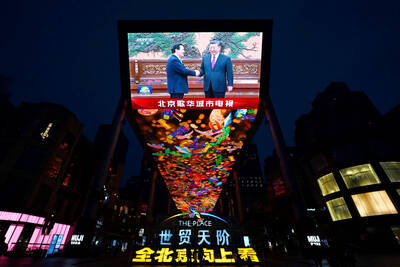
Dr. Y. Tony Yang, Associate Dean of Health Policy and Population Science at George Washington University, argued last week in a piece for the Taipei Times about former president Ma Ying-jeou (馬英九) leading a student delegation to the People’s Republic of China (PRC) that, “The real question is not whether Ma’s visit helps or hurts Taiwan — it is why Taiwan lacks a sophisticated, multi-track approach to one of the most complex geopolitical relationships in the world” (“Ma’s Visit, DPP’s Blind Spot,” June 18, page 8). Yang contends that the Democratic Progressive Party (DPP) has a blind spot: “By treating any
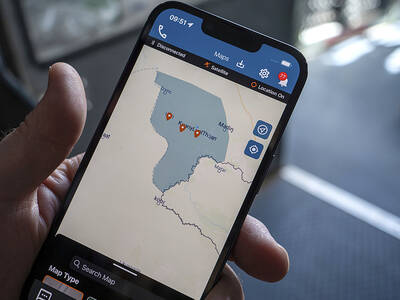
Swooping low over the banks of a Nile River tributary, an aid flight run by retired American military officers released a stream of food-stuffed sacks over a town emptied by fighting in South Sudan, a country wracked by conflict. Last week’s air drop was the latest in a controversial development — private contracting firms led by former US intelligence officers and military veterans delivering aid to some of the world’s deadliest conflict zones, in operations organized with governments that are combatants in the conflicts. The moves are roiling the global aid community, which warns of a more militarized, politicized and profit-seeking trend
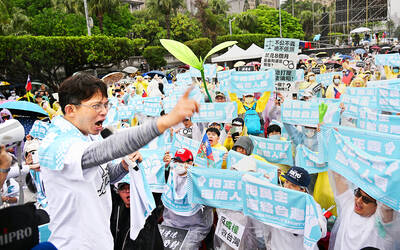
This year will go down in the history books. Taiwan faces enormous turmoil and uncertainty in the coming months. Which political parties are in a good position to handle big changes? All of the main parties are beset with challenges. Taking stock, this column examined the Taiwan People’s Party (TPP) (“Huang Kuo-chang’s choking the life out of the TPP,” May 28, page 12), the Democratic Progressive Party (DPP) (“Challenges amid choppy waters for the DPP,” June 14, page 12) and the Chinese Nationalist Party (KMT) (“KMT struggles to seize opportunities as ‘interesting times’ loom,” June 20, page 11). Times like these can